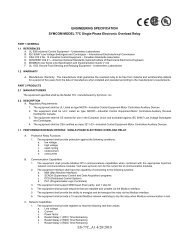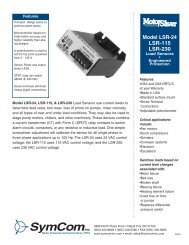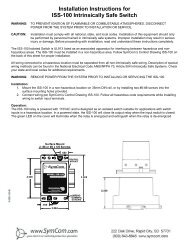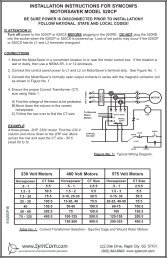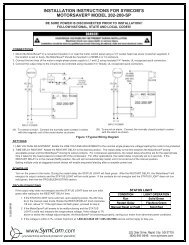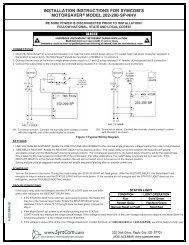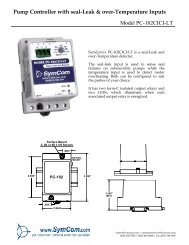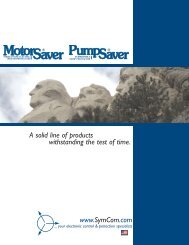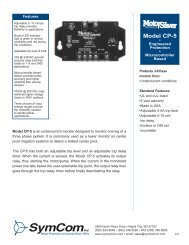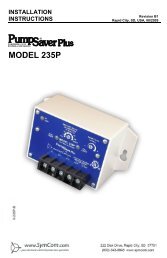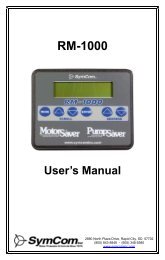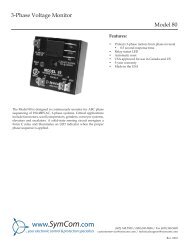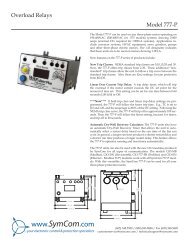installation instructions for the model 777-690-p - SymCom
installation instructions for the model 777-690-p - SymCom
installation instructions for the model 777-690-p - SymCom
Create successful ePaper yourself
Turn your PDF publications into a flip-book with our unique Google optimized e-Paper software.
PROGRAMMING EXAMPLES<br />
Example #1<br />
Motor to be protected: 3-phase, 460 Volt, 25 hp air compressor with full load amperage rating of 34A<br />
and maximum service factor amps of 37.4. Use <strong>the</strong> following calculations and reasoning to<br />
determine <strong>the</strong> appropriate settings <strong>for</strong> this application.<br />
LV- 460 x 0.90 = 414<br />
HV- 460 x 1.10 = 506<br />
VUB- Standard NEMA motor = 5<br />
MULT- From Table 1 = 1<br />
OC- Service Factor Amperage = 37.4<br />
UC- FLA x 0.80 = 34A x 0.80 = 27.2<br />
CUB- Standard NEMA motor = 5<br />
TC- General purpose motor, TC = 20. No linear trip delay is desired, TC also = oFF.<br />
RD1- Since this compressor takes about 10 seconds to bleed off excess pressure after a<br />
shutdown, setting RD1 = 20 will allow <strong>the</strong> compressor to unload be<strong>for</strong>e being restarted.<br />
RD2- Because <strong>the</strong> motor may be hot from running in an unbalance or single phase<br />
condition, a motor cool-down time of 10 minutes, RD2 = 10, should be appropriate.<br />
RD3/#RU- Because an undercurrent would signal a serious problem in this application (a broken<br />
shaft or belt), #RU should be set to 0 <strong>for</strong> a manual reset. There<strong>for</strong>e, RD3 does not<br />
have any function<br />
#RF- Because an overload (overcurrent) fault signals a serious problem in this application<br />
(e.g., worn bearings), "oc" should not be included in <strong>the</strong> #RF setting so that a manual<br />
reset after an overload fault is required. A #RF=1 will give <strong>the</strong> system 1 chance to<br />
recover from an unbalance or single phasing problem be<strong>for</strong>e manual reset is required.<br />
UCTD- Setting UCTD = 5 will allow normal operation and not allow <strong>the</strong> motor to run too long in<br />
a failure mode.<br />
GF- A ground fault setting of 15% of full load amps will be a significant indicator that <strong>the</strong><br />
motor should be evaluated <strong>for</strong> repair or replacement. There<strong>for</strong>e, GF = 34A x 0.15 =<br />
5.1.<br />
Example #2<br />
Motor to be protected: 3-phase, 230 Volt, 5 hp submersible pump with full load amperage of 15.9A<br />
and maximum service factor amps of 18.2. Use <strong>the</strong> following calculations and reasoning to<br />
determine <strong>the</strong> appropriate settings <strong>for</strong> this application.<br />
LV- 230 x 0.90 = 207<br />
HV- 230 x 1.10 = 253<br />
VUB- Manufacturer suggests 5<br />
MULT- From Table 1, MULT = 2, 1 loop of main conductor<br />
OC- Service Factor Amperage = 18.2<br />
UC- FLA x 0.80 = 15.9 x 0.80 = 12.7<br />
CUB- Manufacturer suggests 5<br />
TC- From Table 3, <strong>for</strong> this (and most) submersible pumps, TC = 10. No linear trip delay is<br />
required so TC also is set to oFF.<br />
- 9 -<br />
6/07 A1



